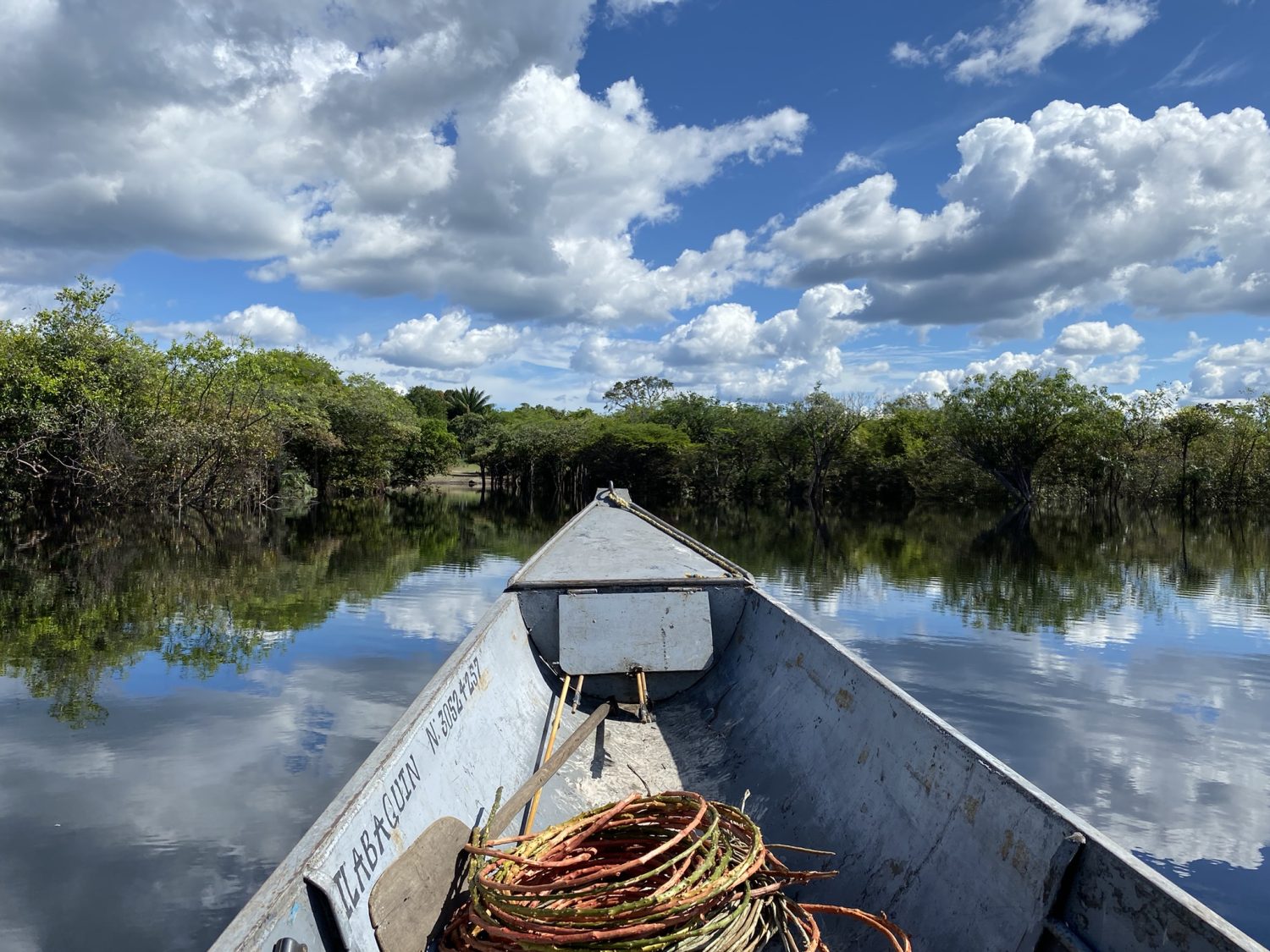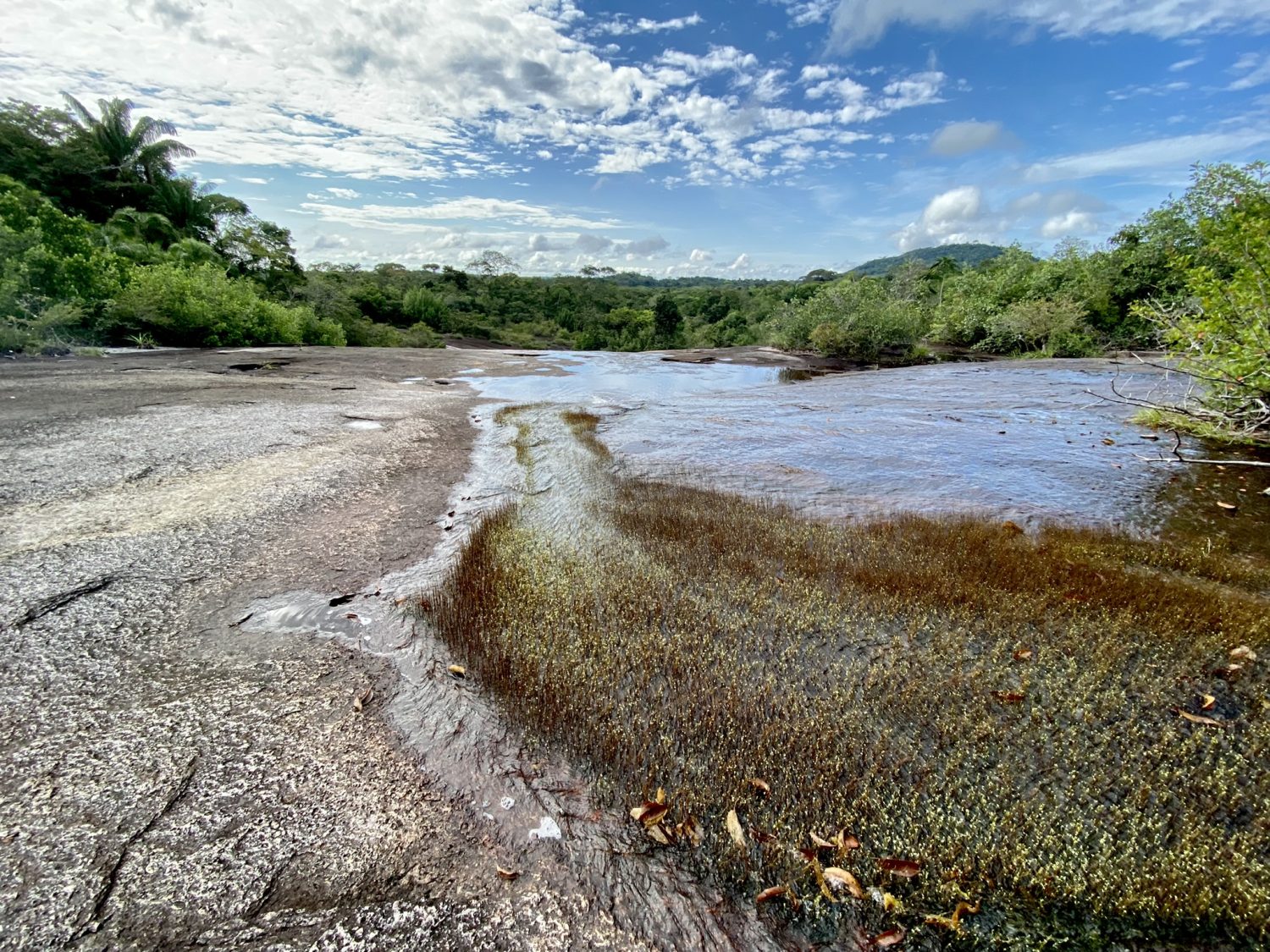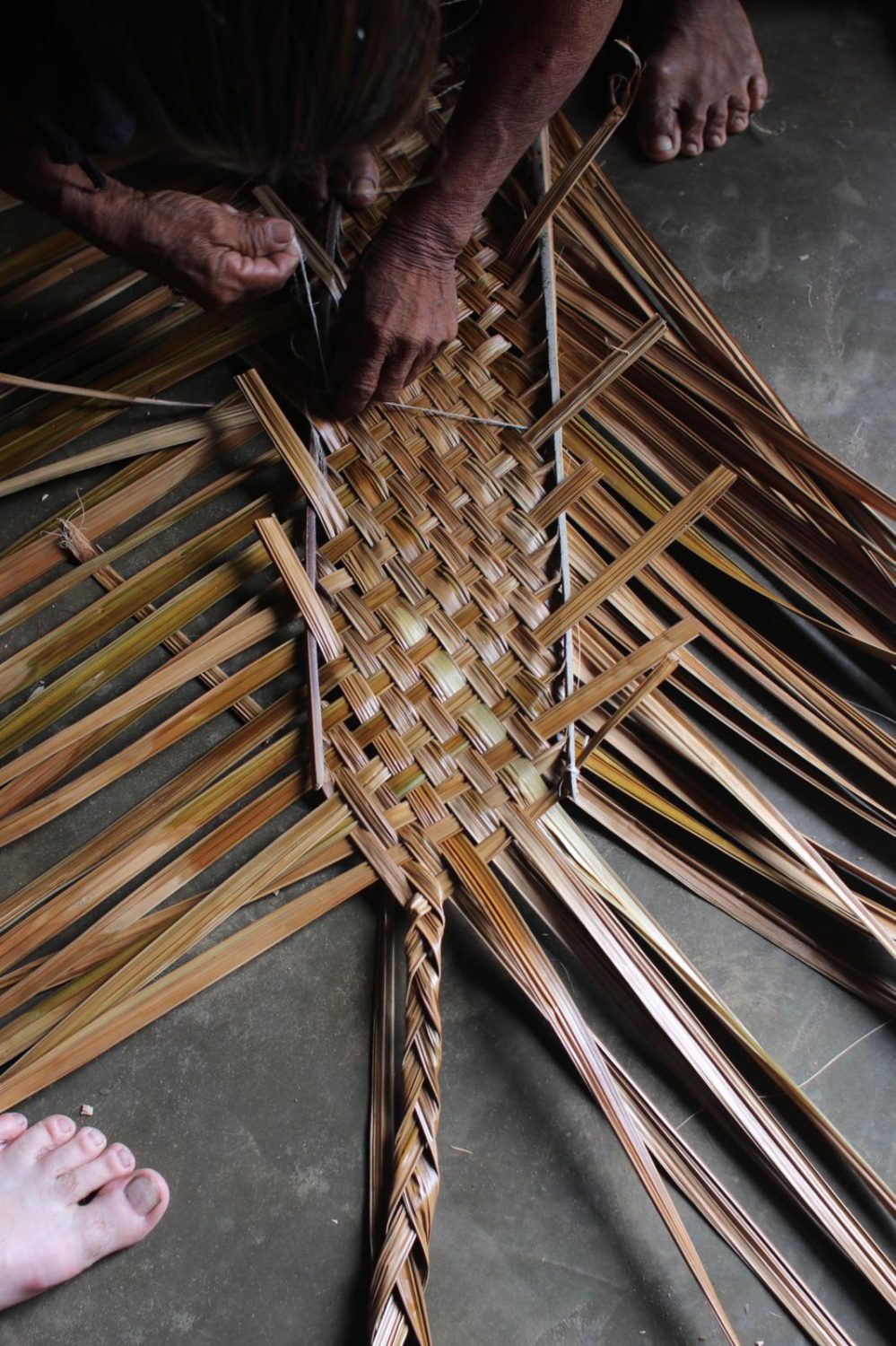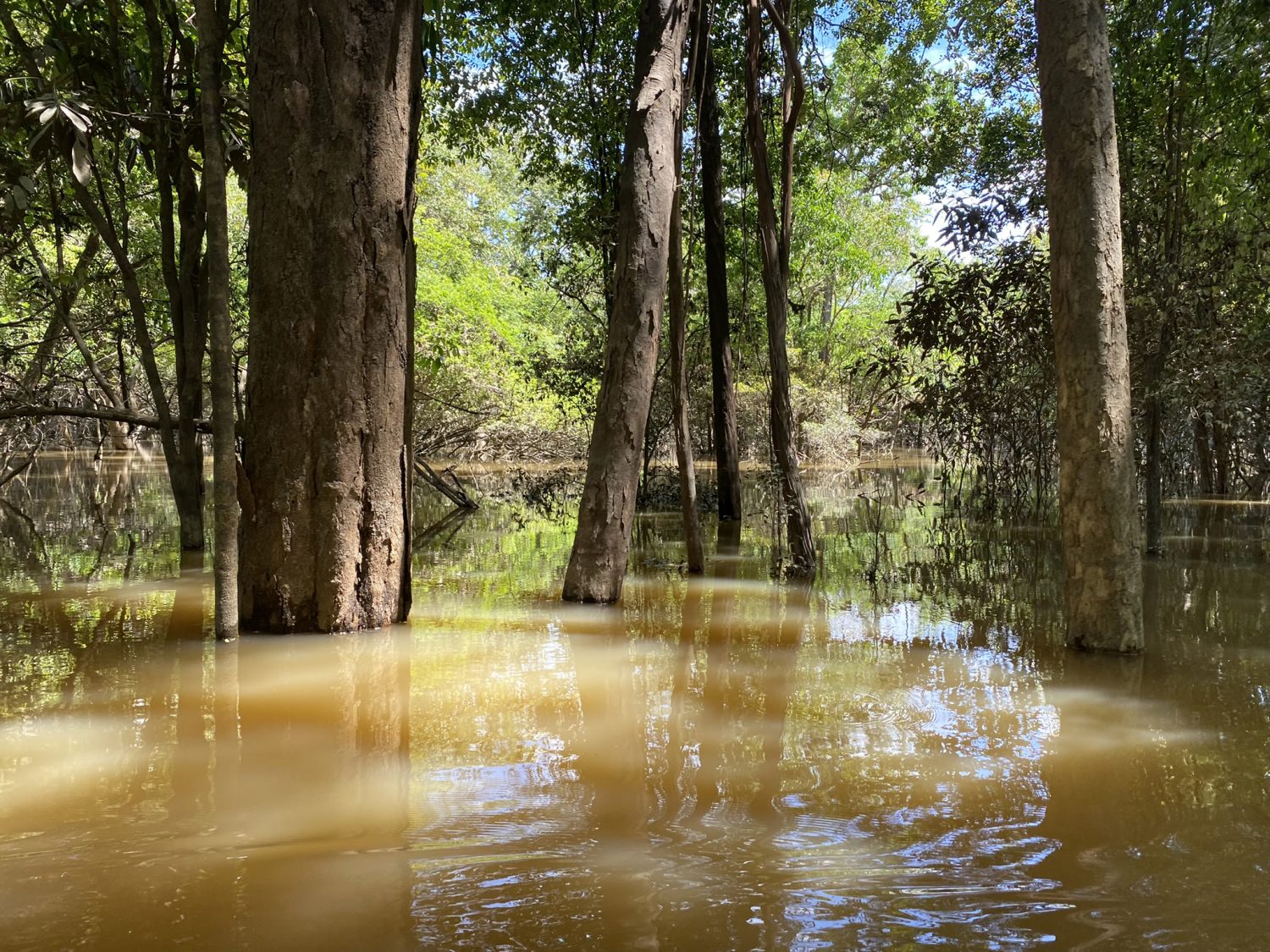Associate Curator Marcela Caldas reflects on a UK-Columbian artist residency project intended to disrupt and transform existing coloniality and border structures.
Back in November 2021, while putting together the Room to Bloom’s program in Palermo, we


were decoding a complex chart of tension with a myriad of centres and peripheries layered along the western border space. It was a time of questioning how a cohort of international artists of diasporic backgrounds, dealing with post-colonial, decolonial, and ecofeminism practices, could briefly intertwine with the local arts scene and activists to induce enduring disruptive effects for all. The British Council international grant for arts open call seemed an excellent opportunity to geographically and institutionally expand this inquiry.
As an associate curator, I am interested in promoting strategies to explore the subversive po-
tential of the arts as a conduit for related fields of action. Drafted with our Colombian ally Organizmo, our project proposal claimed room for radical imagination, creating alliances and conditions for a counter-displacement through the scope of arts. Collectively venturing into the unknown and encouraging encounters beyond the comfort zone of our perspectives, the liminal space and tensions within the so-called margins were to be the primary place of inquiry.
We were keen to explore new strategies for interpersonal, regional, and north-southern alliances to ethically reach alternative self-guarded forms of resistance, values, and dreams. To explore jointly the creative potential of in-between space of multiple cultures, sensitivities, and perceptions and how art can engage in fostering new modes of coexistence.
If separation stands as a binding condition, we were willing to interrogate the forms of exclusion and fragmentation intrinsic to the notion of enclosure, structuring the nation-state framework
and the ruling power relations of our time. To further emancipatory practices for reciprocal care,
to reappropriate time-space from profit, disrupting the linear time of logic of progress. Given the
current crisis driven by an apocalyptic lack of individual agency, we acknowledge the urge to cultivate common interests and lead the process into action, igniting proactive forms of advocacy. The following offers a singular point of view out of the multiple perspectives gathered in this journey.
Building a Transborder Residency
Being aware of the challenging risks of appropriation, exoticization, and fetishization that would reaffirm the geographical and epistemic gaps we aimed to bridge; outreach towards locally established networks of trust was fundamental.
Organizmo was invited to carry on-site mediumship in the frame of its ‘Body, weaving, territory’ art residencies. Organizmo is a private organisation in Colombia that focuses on cultural exchange and ecosystemic regeneration and research: local pioneers in low-impact construction techniques, alternative technologies, ecological restoration, and knowledge-transfer scenarios. The first phase saw UK partners European Alternatives meeting their Colombian allies for a vision session to align values and the shape of the concrete residency. We gathered daily at Casa del Pensamiento – the house for common thought – around a fire, a non-human agency that was a host during the entire process, a space of focus to discuss and fine-tune the collective vibrational intentions in a sort of contemporary ritual.
As a result, the invite expanded to two Colombian artists making for a trans-disciplinary community with a more resourceful set of sensitivities, different languages, backgrounds, and intersecting trajectories. A group of artists on both shores whose interests delved into textiles, water thinking, non-human agencies, spatial research, and knowledge ecologies was selected: Dan Coopey (UK), Daniella Valz-Gen (Peruvian, UK based for 20 years), Siu Vásquez and María Buenaventura (Colombia).

Locating the project
La Urbana is a 140-inhabitant Piaroa settlement located in the tropical rainforest transitional floodplains of the Orinoco River, at the Colombia and Venezuela border. It belongs to ‘Res-
guardo Unificado de la Selva de Matavén’, a protected area of 1,849,613 hectares inhabited by 12,000 indigenous people of seven different ethnic groups, granted a collective property title and autonomous self-governance.
Etnollano, an organisation that has long supported different communities across the region, had previously invited Organizmo to accompany the construction of the Matavén Matawani association’s self-promoted House of Guests over the last few years. The communal construction targets autonomy, self-governance, territorial regeneration, and custody of their living archive, involving all talent in the community. A layout of critical hospitality and relational identity; what could have been an exotic extractive model serving the travel economy regime has been strategically repurposed into a resilient strategy reinforcing circular economy and self-identity across exchange.
Characterised by their organisational faculties and resilient female leadership, La Urbana and
Pueblo Nuevo -twin villages- were willing to extend an invitation to host our program for a
Month.
Bodily Technologies: Deep Listening
Once we met in Organizmo, silence, awareness, and presence were strongly encouraged.
Juanita Delgado, an artist who delves into sound and deep listening as a political practice,
generously joined. Other members of Organizmo’s larger community contributed: Rafael Duarte
artist, Mateo Hernandez Schmitt empirical naturalist, and Barbara Santos electronic artist and researcher, shared insights directing our awareness to the countless co-existing agencies surrounding us. Inviting our bodily agency to rehearsal, to re-enchant matter through our senses: wind, water and fire, pollinators, birds in migration, a ruache (an endemic tree), a frogs’ choir, and the toroidal space to name a few, proved silence to be an abundant place for resonance; for multiple voices to arise and to belong.
The methodology introduced the body as our primary tool for transformation, seeking to counterbalance the bias of logocentric knowledge, preconceptions, and the streams of noise and flow of mediated images circulating at high speed in ego tech echo chambers. Fine-tuning our bodies, opening space to resonate around the fire to who we were and what was next.
Kinship: collective time
Making our way to Matavén, flying into Puerto Inírida, we were welcomed by Eneido, and boated along riverways to meet our hosts, enthusiastic about sharing their way of life and learning new languages. Delcia, Gladiz, Gloria, Yelitza, Yolanda, and Nury, were allocated resources to guide this encounter. We introduced ourselves, our interests, and each artist’s competencies to contribute to any purpose they would identify. Spiralling around their House of Guests, each trajectory and space of action would organically find its way into day-to-day life: cooking, weaving, painting, and storytelling would work as open fields to relate: seeding curiosity, involvement, and constant daily negotiation along the process.
One can travel far and thus travel deep: secluded and disconnected from referential frames, with no compass and no internet, the artist’s self-engagement, endurance, and generosity spanned another pace, sense of place, and time. They were recent acquaintances plunged into uncertainty, contradiction, conflict, and marvel while seeking momentary connection. To show up daily for brief moments of submission: standing thoroughly across others’ routine, relating with no anchor but oneself, displaced and misplaced; while local daily life was disrupted by foreigner’s committed gaze, presence, and labour. To offer and to receive, weighing to maintain, to adapt, to adopt, or reject, portrays the footprint of a unique blend of togetherness harbouring vulnerable threads, each hosting the other within themselves.
The river
Each territory holds a complex multitude of maps. Orinoco River is a line, a border on a political map, and the backbone of regional trade. However, its basin spreads a hyper-sea of myriad bodies of water entangling deep geological, cosmological, and atmospheric time. Younger sources spring from Los Andes mountain ranges, and the black and red waters source from the earth, mingling into la Estrella fluvial (river star). Sonic fluidity runs through magnetic fields of frequencies: all life breathes in continuity, symbiotically exhaling with it. Its temporalities dictate life’s calendar. Amid shifting atmospheres, we navigated among tree canopies, emerging sand, and stones, meandering a fluctuating horizon of undrawn confinement. La Urbana stands protected as a refuge in constant transit of presence, surrounded by amphibious cartographies. All that is above is below. For Piaroa’s cosmology, the entire cosmos lies within the self. Water stands as the great divide and the great connector: circulating across all living entities.

Recipes as thresholds
María, whose practice centres on local food production systems, was called to exchange recipes in diverse kitchen typologies managed by women. The yuca brava, a poisonous tubercle and its by-products, constitutes the Amazon-Orinoquian region’s base diet, similar to wheat or corn. We joined the processing of the yuca brava, a refined technology performed over thousands of years of laborious process and joint effort to seed, harvest, ferment and roast.
The larger traditional collective unit activated during our stay and a few household units altogether hosted a diffused alchemical laboratory merging flavours into daily routines. Eating and cooking are connection rituals: the daily fishing, hunting, and fruit picking would provide a full spectrum of bodily exchange circulating an entire landscape through our bodies. For María all ingredients hold a story and stand as memory-keepers, gathering a living archive, thresholds for a territory-entrenched dance.
Food becomes an act of resistance, a place for nurturing and celebrating life, and of offering. It takes a river and its entire supporting life system to perform a traditional recipe. It takes a sense of risk, knowledge, and great curiosity to attempt an unprecedented sourdough of yuca brava that María brought to life and fermented with daily care.
Weaving
Later on, a Catumare – a yuca brava back carrier- was our introduction to weaving hands-on:
a technique the elders Gloria and Gladys taught. While remembering, younger women became
aware of its loss. Local fibres were for decades intensively deployed, the fibre source was three day’s distance away. To have had the opportunity to journey to collect the living matter radically shifted our tactile and spatial perception of the amount of labour and nature weavers pour into their craft.
Despite Dan’s limited Spanish, weaving allowed a quantic bridge, a cross-cultural language
regardless of precedence or gender role identification, serving as a medium for exploration,
earnestly exchanging each other’s techniques. The power of shared expertise seeking to solve
common questions revealed collective intelligence to a lonesome weaver, as Dan has never
experienced before. Informed by the tension between the hard fibres at hand and their bodies,
the quest brought to life artefacts unique to this encounter, to its time and place, not without
struggle.
We are the stories we tell
For Daniella, an artist and oracle, a migrant, a weaver of the non-tangible, the river was her main interest. The fluid entity portrayed resonance for her unique blend of critical sensitivity and ability to articulate words as vessels.
She was requested directly by young Melissa to support the transcription of her grandmother’s stories. Storytelling retrieves wisdom demanding responsibility to learn. Hector, the local professor and translator explained how Piaroas’ language beyond discourse animates life: an
encrypted memory system written across a vast territory. Stories are not myths nor old; they are
circular communication of the memory of all existing things. Navigation charts for the present,
given in the past and orally passed into the future. Orality is constantly risking its loss; the lesser
stories told, the more knowledge gets forever lost. To remember –recordare in Latin- to pass
back through the heart becomes essential.
The written word practice may not be as visually laborious from a gender role perspective, considering the feminine relies on strong physical performativity in Piaroa’s way of life. Daniella stood lost in translation but rooted in presence: actively listening while holding space, vulner-
ably surrendering to the unbridgeable gap of translational grey-zones. The foreigner condition entails a continuous search for identification and bonding. The effort to channel continuity in a broken line of transfer between generations, seeking to identify brief glimpses of women’s universes was insightful, yet significantly challenging. Intimate dialogues would nurture empathy, a feeling of bareness.
Stone and clay: deep time
Siu’s situated practice as a South American, as a woman, a painter interrogates the politics of representation, delving into the political material agency technique and its support. She is interested in challenging the notion of privilege, referred to as contemplation against the privilege of embodied creative labour.
Mainly a painter, she displayed an open blank field to jointly draw which symbols convey men’s and women’s universes into a series of four visual narrative frames commonly identified, discussed and articulated.
Piaroa’s large territory constitutes a memory system in which petroglyphs are encrypted forces
of non-human potentia carved in particular ancient geological formations, the oldest in America,
which we also had the opportunity to visit. Working with a delicate palette of river clays recently collected by Ana, the youngest layers of sediment will merge deep time temporalities into second-skin gestures, depicting friezes across the earthy walls of the House of guests. Appointed by the community to collaborate as an artist, she held space for Marlon to explore new techniques and to co-execute the work. ‘The difference between art and crafts mainly resides in intention’, she states.
Siu acted as the speaker coordinating the daily artists’ program with their hosts. Delcia, one of the leaders, expressed how much they have appreciated exploring suspended
time to create for the pleasure of it, not for profit or utilitarian purposes.
Critical Hospitality
Hosted by the – Colectivo Los Camellones de Suba- part of Maria’s ongoing research: we vis-
ited the recreation of a fragment of what the valley marshes were once upon a time: shaped by sophisticated canals and an amphibious agricultural ecosystem, planted with corn, hunting duck and fishing ‘pez capitán’: a fish she found to be part of the local diet basis for millenniums. Vanished radically from our territories and collective memory, fishing in canals used to be a daily
scene very few today know about. It was also one of the main drives for María to visit Matavén.
Kilometers away from where the Orinoco River source springs in the Andes mountains, the Piaroa women would meet Muisca leader Abuela Blancanieves to picnic and share stories. The violent punishing the evangelization inflicted on all forms of water worship during the colony,
the most sacred element for the Muiscas, could partially explain the unaffectionate relationship
Bogotá keeps to its abundant bodies of water nowadays; poisoned and large-scale urbanized,
the Bogotá River can hardly breathe. In these terms, what does it mean to inhabit a territory with
no grip on its memory? What can we seed, harvest and eat to reconnect to our ancestral origin?
Cooking for Maria is a ritual, her offering, and her chant.
To offer cheerful resistance and persistence to our guests, we cooked with María for an entire afternoon, a laborious mountain recipe: ‘tamales de pipián con ají de maní’, a memory of precious knowledge to not get lost.
The take away
As I write this, transformation keeps taking place, forcing us to observe and constantly re-situate
ourselves back in our different homes. We last traveled to Bath, a UK city of thermal waters and
canals, a middle-aged wool town not far from Dan’s homeland, where he learned weaving from
his family background and ancient tradition. Once in London, a conversation followed to share
the current state of questioning and digestion of experience.
Despite the distance, the United Kingdom and Orinoquia have a shared story. Amazon and Orinoquia regions have been portrayed historically as ambiguous spaces; geographies of sacrifice for capital since the encounter with the Western Imperial project, during the colony up to now. They have remained offshore of the bright narratives of modern progress. Nonetheless, the 19th-century industrial revolution was upheld by their slave labour, evangelization, and resource exploitation, foremost with rubber deployment.
The novels ‘La Vorágine’ by Jose Eustasio Rivera at Colombia’s Border and Josep Conrad’s ‘Heart of Darkness’ in the Congo, denounced the brutality inflicted on these cultures and their support life system. By the time slavery was exposed and abolished, the debt system was implemented, alongside the newborn nation-states economies, perfectioned to the core of financial practices still in force at a planetary scale. The ongoing dynamic of extraction still inflicts massive pressure on these lands and their human and non-human inhabitants, with resumed violence since the launch of global neoliberal trading policies in the 80s. Far from being the margins constructed by the colonial gaze, these regions are the concrete vortex of the capital annihilation mechanisms. The silent scenarios of inflicted wounds spiral an array of rootless accumulation, machinery, and domination decay.
A significant shift of sensibility may have occurred under the hurtling crisis of our time. Nevertheless, the exoticizing and romanticising portrayals around ancestrality threaten to evolve into renewed forms of cultural extraction and neocolonialism, from environmental crusades to mining, deforestation, water privatisation, the carbon bonus market, and ongoing marginalizing racism.
After all, colonialism is a matter of perspective. It’s siding with Humboldt’s unfortunate mirage of reason, portraying unpopulated scenes of vast no-man land to conquer and its limitless resources for extraction. ”Hell-on-earth narratives of explorers lack the complex and sophisticated knowledge of what these lands require to inhabit: there is nothing such as inert matter or untouched nature. Positivist materialism and enlightenment imagery uphold the illusional notion of genius, a glorified fragmentation between civilization and nature detaching us radically from the
embedded agency of reciprocal life networks of all territories, thousands of years ago and across latitudes.
We visited London’s most relevant museums exhibiting a large inventory of a self-affirming display of domination and superiority: categorised objects lie captured, deprived of any dynamic interaction of all complex entanglements and forces of life bringing them to existence.
These collections are further a chronicle of Western deafness to the delicate webs of life intelligence buried under the devastating effects of extraction; from a vital point of view, the museum self-guards a magnificent archive of silent enchanted matter, self-reflecting our equally broken need for rooted relation and belonging. As Hector explains: war lives inwards, always.
Healing is an art: it takes care and takes time
It is precisely in that liminal space of discordance where all potential and ground for healing and
transforming reality reside. A re-enchantment of the world as the feminist theorist and activist Silvia Federici explains; to reconnect what capitalism has divided: our relationship with nature, others, and our bodies.
Slowing down, decompressing time and space, the Organizmo Bloom program has offered unusual frames and conditions recentering the body’s ever-evolving technological extensions for subtle perception. A force only delivered by confronting reality. Bodies immersed in an experience of real displacement, carriers of the power of contagion, responsible for their resonances, critical of their practices, seeking to equalize unstable positions to breathe a source of oxygen into their singular devices: accumulating gestures of affection sensibly evolving into action.
Daily conversations will cross-pollinate questions, ideas, mutual learning, and attitudes for art to shape and be shaped in tune with what the flowing current of life demands. The potential of the multitude is activated by the subversive power of kinship, subverting the myth of the genius artist in constant competition and isolation. Weaving commons out of time in reciprocal care is how deep transformational micro-politics take shape; to be entangled becomes a source of renewal and creativity: it is all relational. Encounter as a profound school for transformation.
With intersectional forms of commitment between interacting communities: territories, private and public institutions, art practitioners, and grassroots associations enacting a transformative
consciousness of the totality. As Edouard Glissant’s view, it is ‘archipelago thinking’: the ecology of resonating isles of resistance is neither contained nor closed but an opening to conform diversity. A strategic rhizomatic network branching outwards infinitely in constant re-affirmation, connected in boundless multiplicity: ‘Where all the world’s imagination can meet in understanding without being dispersed or lost.’
A mobile device that is neither hierarchical nor antagonistic but situated, temporal, and contin-
gent, without an imagined origin or endpoint. Provoking between the particularity and the total-
ity, the insurrection of the collective imaginary faculties.
Agents of change in proliferation and emancipatory practices of conviviality institute the power
to rewrite a new kind of entity from our shared history, an exchange of knowledge with infinite
potential: our great archive is the one yet to be unfolded. As Alain Badiou asserts: art can also
be its reverse and constitute a promise, unveiling the buried secrets of the world, not solely by
representing and documenting the disaster but by offering unprecedented visions of what we
can be and can achieve to thrive.
Marcela Calas (Bogotá 1977) is an Italian based multidisciplinary researcher and curator working at the intersection of power relations, ecology and arts. She is curator of the Organizmo Bloom project.
